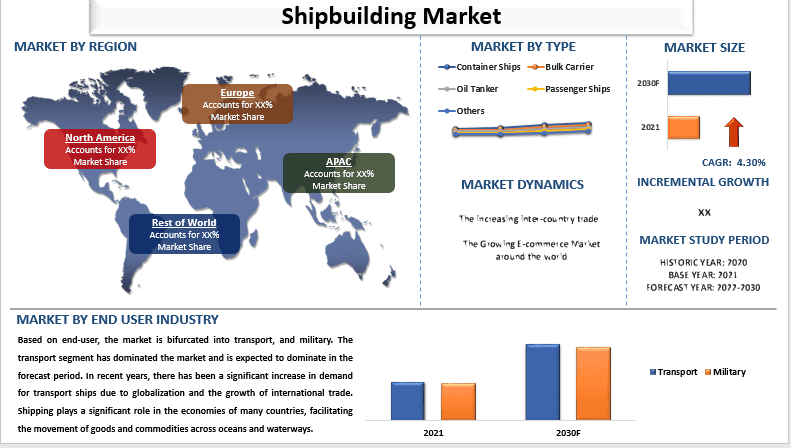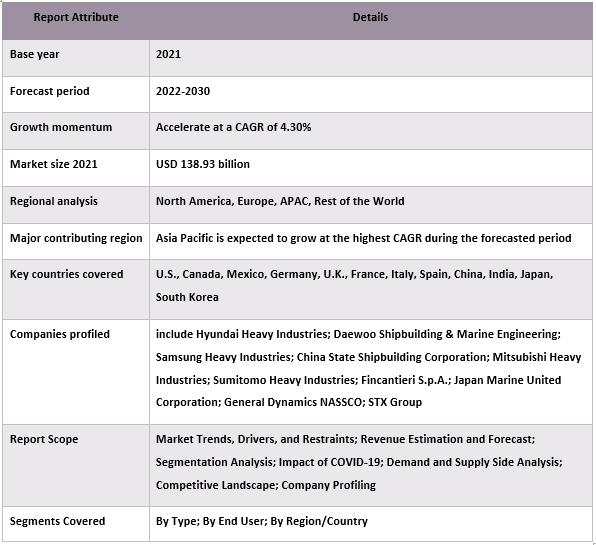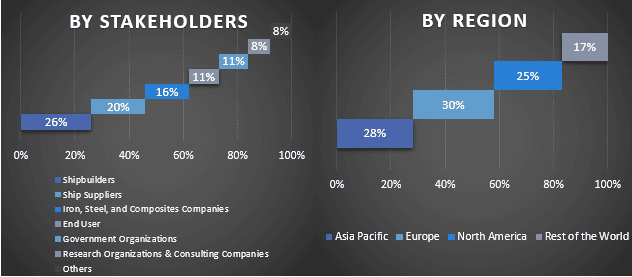- Trang chủ
- Về chúng tôi
- Ngành
- Dịch vụ
- Đọc
- Liên hệ với chúng tôi

Thị trường đóng tàu dự kiến sẽ tăng trưởng với tốc độ CAGR mạnh mẽ khoảng 4,30% trong giai đoạn dự báo do nhu cầu thương mại điện tử ngày càng tăng.Nhu cầu thương mại điện tử ngày càng tăng đã có tác động đáng kể đến ngành hậu cần và vận chuyển. Với ngày càng có nhiều người chọn mua sắm trực tuyến do sự gia tăng thâm nhập của thiết bị di động và các gói dữ liệu giá rẻ do các công ty viễn thông cung cấp và mua hàng được giao đến tận cửa nhà, đã có sự bùng nổ tương ứng về nhu cầu các giải pháp giao hàng hiệu quả để đảm bảo giao hàng kịp thời và đáng tin cậy.Ví dụ, vào tháng 3 năm 2022, theo báo cáo do Cơ quan Quản lý Thương mại Quốc tế, một cơ quan thuộc Bộ Thương mại Hoa Kỳ, doanh số thương mại điện tử ở Canada được ước tính vào khoảng 2,34 tỷ USD vào tháng 3 năm 2022 và dự kiến sẽ đạt doanh số bán lẻ thương mại điện tử là 40,3 tỷ USD vào năm 2027.Do đó, nhu cầu ngày càng tăng đối với thương mại điện tử sẽ tác động tích cực đến ngành đóng tàu trong những năm tới.
Một số người chơi chính đang hoạt động trên thị trường bao gồm Hyundai Heavy Industries; Daewoo Shipbuilding & Marine Engineering; Samsung Heavy Industries; Tập đoàn Đóng tàu Trung Quốc; Mitsubishi Heavy Industries; Sumitomo Heavy Industries; Fincantieri S.p.A.; Japan Marine United Corporation; General Dynamics NASSCO; Tập đoàn STX. Một số thương vụ M&A cùng với quan hệ đối tác đã được các đối thủ này thực hiện để tạo điều kiện cho khách hàng với các sản phẩm/công nghệ công nghệ cao và sáng tạo.
Thông tin chi tiết được trình bày trong báo cáo
“Trong số các loại, phân khúc container chiếm thị phần lớn nhất vào năm 2021”
Dựa trên loại hình, thị trường được chia thành tàu container, tàu chở hàng rời, tàu chở dầu, tàu chở khách và các loại khác (Tàu hải quân, Tàu kéo, v.v.). Danh mục tàu container đã nắm giữ thị phần lớn nhất trong năm lịch sử và dự kiến sẽ thấy xu hướng tương tự trong giai đoạn dự báo. tàu container được thiết kế để vận chuyển một lượng lớn hàng hóa trong các container tiêu chuẩn. những tàu đó cung cấp nhiều lợi ích so với các phương thức vận chuyển khác, cùng với xe tải, tàu hỏa và máy bay, về tốc độ, chi phí và hiệu quả. Ví dụ, một con tàu thông thường có thể chở tới 20.000 container, tương đương với khoảng 200.000 tấn hàng hóa. Dung lượng lớn như vậy cho phép các doanh nghiệp vận chuyển đạt được hiệu quả kinh tế theo quy mô, giảm chi phí vận chuyển và hoạt động hiệu quả hơn. Ngành vận chuyển container cũng được hưởng lợi từ toàn cầu hóa, điều này đã dẫn đến sự gia tăng thương mại quốc tế. Hơn nữa, một yếu tố khác đã góp phần vào sự tăng trưởng của vận chuyển container là sự phát triển của các cảng chuyên dụng và các bến container. Các trung tâm này được thiết kế để giải quyết một lượng lớn container đóng gói một cách hiệu quả, giảm thời gian quay vòng và tăng năng suất. Ví dụ, Cảng Thượng Hải ở Trung Quốc là cảng container bận rộn nhất thế giới, xử lý hơn bốn mươi triệu TEU (thiết bị tương đương hai mươi feet) mỗi năm. Ngoài ra, Cảng Rotterdam ở Hà Lan là cảng container lớn nhất châu Âu, quản lý hơn 14 triệu TEU hàng năm.
“Trong số người dùng cuối, phân khúc vận tải chiếm ưu thế trên thị trường vào năm 2021”
Dựa trên người dùng cuối, thị trường được phân chia thành vận tải và quân sự. Phân khúc vận tải đã thống trị thị trường và dự kiến sẽ thống trị trong giai đoạn dự báo. Trong những năm gần đây, nhu cầu tàu vận tải đã tăng lên đáng kể do toàn cầu hóa và sự tăng trưởng của thương mại quốc tế. Vận chuyển đóng một vai trò quan trọng trong nền kinh tế của nhiều quốc gia, tạo điều kiện cho việc di chuyển hàng hóa và hàng hóa trên các đại dương và đường thủy. Hơn nữa, những tiến bộ công nghệ đóng một vai trò quan trọng trong việc xác định sự thống trị của phân khúc vận tải và quân sự trong thị trường đóng tàu. Sự phát triển của công nghệ đóng tàu tiên tiến đã cho phép các nhà đóng tàu lắp ráp các con tàu có thể nhanh hơn, hiệu quả hơn và thân thiện với môi trường hơn. Những tiến bộ công nghệ này đã cho phép phân khúc vận tải tăng hiệu suất và giảm tác động đến môi trường.
“Châu Á Thái Bình Dương chiếm ưu thế trên thị trường đóng tàu vào năm 2021”
Châu Á Thái Bình Dương được dự kiến là khu vực phát triển nhanh nhất trong giai đoạn dự báo do công nghiệp hóa nhanh chóng, dân số ngày càng tăng và chi phí lao động thấp. một trong những lý do quan trọng khiến khu vực Châu Á - Thái Bình Dương chiếm lĩnh thị trường đóng tàu là chi phí lao động thấp và sự hiện diện của những người lao động lành nghề. Các quốc gia ở Châu Á - Thái Bình Dương có chi phí lao động thấp hơn so với các khu vực khác, dẫn đến chi phí sản xuất tổng thể thấp hơn. Điều này đã mang lại cho các quốc gia này một lợi thế cạnh tranh cho phép họ cung cấp các dịch vụ đóng tàu với chi phí thấp hơn so với các đối thủ cạnh tranh của họ. Khu vực Châu Á - Thái Bình Dương là nơi có trữ lượng thép, nhôm và các nguyên liệu thô khác được sử dụng trong ngành đóng tàu. Hàn Quốc là một ví dụ điển hình về một quốc gia Châu Á - Thái Bình Dương đã tạo dựng được vị thế vững chắc trong ngành đóng tàu trên toàn thế giới. Các nhà đóng tàu Hàn Quốc, cùng với Hyundai Heavy Industries, Samsung Heavy Industries và Daewoo Shipbuilding and Marine Engineering, nằm trong số những công ty được kính trọng nhất trong ngành.
Phạm vi Báo cáo Thị trường Đóng tàu

Lý do mua báo cáo này:
- Nghiên cứu bao gồm phân tích về quy mô và dự báo thị trường được xác nhận bởi các chuyên gia chủ chốt trong ngành đã được xác thực.
- Báo cáo trình bày một bản tóm tắt nhanh về hiệu suất tổng thể của ngành trong nháy mắt.
- Báo cáo bao gồm phân tích chuyên sâu về các công ty cùng ngành nổi bật với trọng tâm chính là các vấn đề tài chính kinh doanh chính, danh mục sản phẩm, chiến lược mở rộng và những phát triển gần đây.
- Kiểm tra chi tiết về các yếu tố thúc đẩy, hạn chế, xu hướng chính và cơ hội hiện có trong ngành.
- Nghiên cứu bao gồm toàn diện thị trường trên các phân khúc khác nhau.
- Phân tích chuyên sâu cấp độ khu vực của ngành.
Tùy chọn tùy chỉnh:
Thị trường đóng tàu toàn cầu có thể được tùy chỉnh thêm theo yêu cầu hoặc bất kỳ phân khúc thị trường nào khác. Bên cạnh đó, UMI hiểu rằng bạn có thể có nhu cầu kinh doanh riêng, do đó, hãy thoải mái kết nối với chúng tôi để có được một báo cáo hoàn toàn phù hợp với yêu cầu của bạn.
Mục lục
Phương pháp Nghiên cứu để Phân tích Thị trường Đóng tàu (2022-2030)
Phân tích thị trường trong quá khứ, ước tính thị trường hiện tại và dự báo thị trường trong tương lai của thị trường đóng tàu toàn cầu là ba bước chính được thực hiện để tạo và phân tích việc áp dụng đóng tàu ở các khu vực chính trên toàn cầu. Nghiên cứu thứ cấp toàn diện đã được tiến hành để thu thập số liệu thị trường trong quá khứ và ước tính quy mô thị trường hiện tại. Thứ hai, để xác thực những hiểu biết sâu sắc này, nhiều kết quả và giả định đã được xem xét. Hơn nữa, các cuộc phỏng vấn sơ cấp chuyên sâu cũng đã được tiến hành, với các chuyên gia trong ngành trên toàn bộ chuỗi giá trị của thị trường đóng tàu toàn cầu. Sau khi giả định và xác nhận số liệu thị trường thông qua các cuộc phỏng vấn chính, chúng tôi đã sử dụng phương pháp từ trên xuống/từ dưới lên để dự báo quy mô thị trường hoàn chỉnh. Sau đó, các phương pháp phân tích thị trường và phương pháp tam giác hóa dữ liệu đã được áp dụng để ước tính và phân tích quy mô thị trường của các phân khúc và phân khúc phụ của ngành. Phương pháp chi tiết được giải thích dưới đây:
Phân tích Quy mô Thị trường Lịch sử
Bước 1: Nghiên cứu chuyên sâu về các Nguồn thứ cấp:
Nghiên cứu thứ cấp chi tiết đã được tiến hành để có được quy mô thị trường trong quá khứ của thị trường đóng tàu thông qua các nguồn nội bộ của công ty nhưbáo cáo thường niên & báo cáo tài chính, bản trình bày hiệu suất, thông cáo báo chí, v.v.,và các nguồn bên ngoài bao gồmtạp chí, tin tức & bài viết, ấn phẩm của chính phủ, ấn phẩm của đối thủ cạnh tranh, báo cáo ngành, cơ sở dữ liệu của bên thứ ba và các ấn phẩm đáng tin cậy khác.
Bước 2: Phân khúc Thị trường:
Sau khi có được quy mô thị trường trong quá khứ của thị trường đóng tàu, chúng tôi đã tiến hành phân tích thứ cấp chi tiết để thu thập thông tin chi tiết về thị trường trong quá khứ và chia sẻ cho các phân khúc & phân khúc phụ khác nhau cho các khu vực chính. Các phân khúc chính được bao gồm trong báo cáo theo loại hình và người dùng cuối. Phân tích cấp quốc gia hơn nữa đã được tiến hành để đánh giá việc áp dụng tổng thể các mô hình thử nghiệm trong khu vực đó.
Bước 3: Phân tích Yếu tố:
Sau khi có được quy mô thị trường trong quá khứ của các phân khúc và phân khúc phụ khác nhau, chúng tôi đã tiến hành mộtphân tích yếu tốchi tiết để ước tính quy mô thị trường hiện tại của thị trường đóng tàu. Hơn nữa, chúng tôi đã tiến hành phân tích yếu tố bằng cách sử dụng các biến phụ thuộc và độc lập như loại hình và người dùng cuối của thị trường đóng tàu. Phân tích kỹ lưỡng đã được tiến hành đối với các kịch bản cung và cầu có tính đến các quan hệ đối tác hàng đầu, sáp nhập và mua lại, mở rộng kinh doanh và ra mắt sản phẩm trong lĩnh vực thị trường đóng tàu trên toàn cầu.
Ước tính & Dự báo Quy mô Thị trường Hiện tại
Quy mô Thị trường Hiện tại:Dựa trên những hiểu biết có thể hành động từ 3 bước trên, chúng tôi đã đi đến quy mô thị trường hiện tại, những người chơi chính trên thị trường đóng tàu toàn cầu và thị phần của các phân khúc. Tất cả các phân chia tỷ lệ phần trăm và phân tích thị trường cần thiết đã được xác định bằng cách sử dụng phương pháp thứ cấp nói trên và đã được xác minh thông qua các cuộc phỏng vấn chính.
Ước tính & Dự báo:Đối với ước tính và dự báo thị trường, trọng số đã được gán cho các yếu tố khác nhau bao gồm các yếu tố thúc đẩy & xu hướng, hạn chế và cơ hội dành cho các bên liên quan. Sau khi phân tích các yếu tố này, các kỹ thuật dự báo có liên quan, tức là phương pháp từ trên xuống/từ dưới lên, đã được áp dụng để đưa ra dự báo thị trường cho năm 2030 cho các phân khúc và phân khúc phụ khác nhau trên các thị trường chính trên toàn cầu. Phương pháp nghiên cứu được áp dụng để ước tính quy mô thị trường bao gồm:
- Quy mô thị trường của ngành, xét về doanh thu (USD) và tốc độ áp dụng thị trường đóng tàu trên các thị trường chính trong nước
- Tất cả các tỷ lệ phần trăm, phân chia và phân tích của các phân khúc thị trường và phân khúc phụ
- Những người chơi chính trên thị trường đóng tàu toàn cầu xét về các sản phẩm được cung cấp. Ngoài ra, các chiến lược tăng trưởng được các đối thủ này áp dụng để cạnh tranh trên thị trường đang phát triển nhanh chóng
Xác nhận Quy mô và Thị phần Thị trường
Nghiên cứu chính:Các cuộc phỏng vấn chuyên sâu đã được tiến hành với các Nhà lãnh đạo Ý kiến chính (KOL) bao gồm các Giám đốc điều hành cấp cao (CXO/VPs, Trưởng phòng Kinh doanh, Trưởng phòng Marketing, Trưởng phòng Điều hành, Trưởng phòng Khu vực, Trưởng phòng Quốc gia, v.v.) trên các khu vực chính. Các phát hiện nghiên cứu chính sau đó được tóm tắt và phân tích thống kê đã được thực hiện để chứng minh các giả thuyết đã nêu. Đầu vào từ nghiên cứu chính đã được hợp nhất với các phát hiện thứ cấp, do đó biến thông tin thành những hiểu biết có thể hành động.
Phân chia người tham gia chính ở các khu vực khác nhau

Kỹ thuật thị trường
Kỹ thuật tam giác dữ liệu đã được sử dụng để hoàn thành ước tính thị trường tổng thể và để đưa ra các con số thống kê chính xác cho từng phân khúc và phân khúc phụ của thị trường đóng tàu toàn cầu. Dữ liệu được chia thành một số phân khúc và phân khúc phụ sau khi nghiên cứu các thông số và xu hướng khác nhau trong các lĩnh vực loại hình và người dùng cuối trong thị trường đóng tàu toàn cầu.
Mục tiêu chính của Nghiên cứu Thị trường Đóng tàu Toàn cầu
Các xu hướng thị trường hiện tại và tương lai của thị trường đóng tàu toàn cầu đã được xác định trong nghiên cứu. Các nhà đầu tư có thể thu được những hiểu biết chiến lược để làm cơ sở cho quyết định đầu tư của họ dựa trên phân tích định tính và định lượng được thực hiện trong nghiên cứu. Các xu hướng thị trường hiện tại và tương lai xác định sức hấp dẫn tổng thể của thị trường ở cấp độ khu vực, cung cấp một nền tảng để người tham gia công nghiệp khai thác thị trường chưa được khai thác để hưởng lợi từ lợi thế đi đầu. Các mục tiêu định lượng khác của các nghiên cứu bao gồm:
- Phân tích quy mô thị trường hiện tại và dự báo của thị trường đóng tàu tính theo giá trị (USD). Ngoài ra, hãy phân tích quy mô thị trường hiện tại và dự báo của các phân khúc và phân khúc phụ khác nhau
- Các phân khúc trong nghiên cứu bao gồm các lĩnh vực loại hình và người dùng cuối
- Xác định và phân tích khung pháp lý cho ngành đóng tàu
- Phân tích chuỗi giá trị liên quan đến sự hiện diện của nhiều trung gian khác nhau, cùng với việc phân tích hành vi của khách hàng và đối thủ cạnh tranh của ngành
- Phân tích quy mô thị trường hiện tại và dự báo của thị trường đóng tàu cho khu vực chính
- Các quốc gia chính của các khu vực được nghiên cứu trong báo cáo bao gồm Châu Á Thái Bình Dương, Châu Âu, Bắc Mỹ và Phần còn lại của Thế giới
- Hồ sơ công ty của thị trường đóng tàu và các chiến lược tăng trưởng được áp dụng bởi những người tham gia thị trường để duy trì trong thị trường đang phát triển nhanh chóng
- Phân tích chuyên sâu cấp độ khu vực của ngành
Liên quan Báo cáo
Khách hàng đã mua mặt hàng này cũng đã mua










